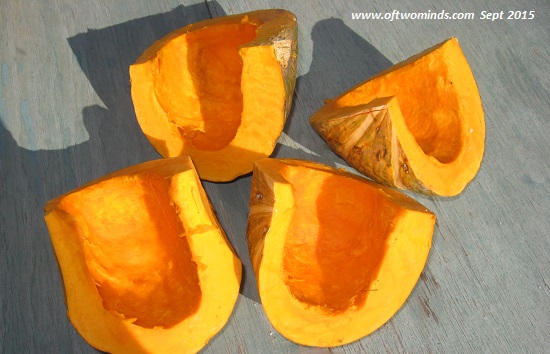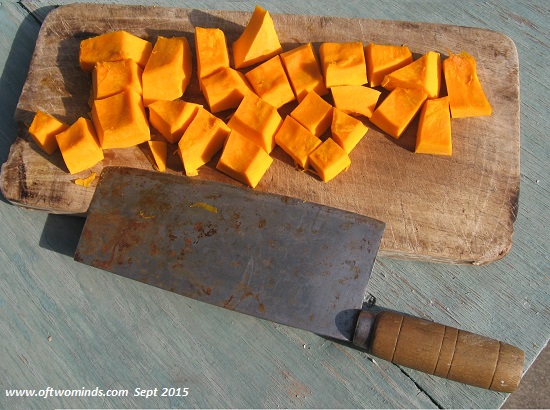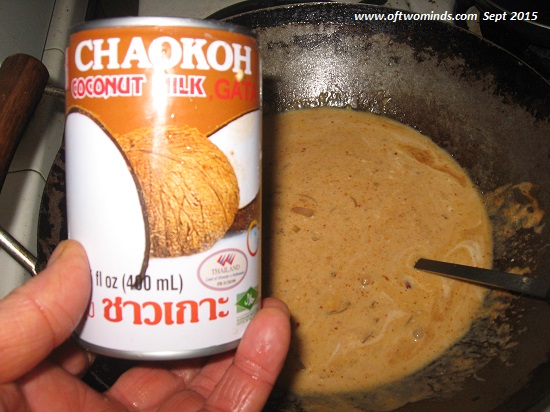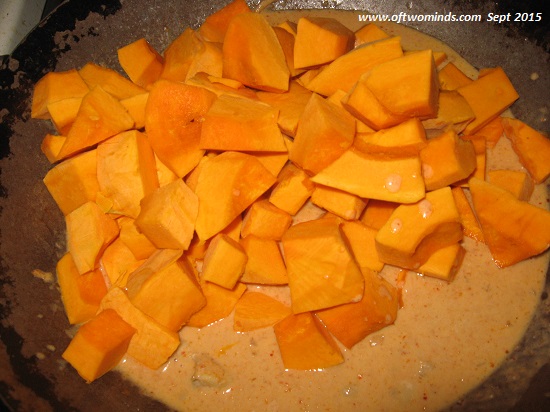What's Cooking at Our House: Thai Pumpkin-Chicken Curry
October 3, 2015
Thai Pumpkin-Chicken Curry is a classic that's very forgiving of minor variations.
At the suggestion of correspondent Paul S., I'm presenting a new What's Cooking at Our House: Thai Pumpkin-Chicken Curry. This is a favorite in our house for several reasons: it's a good main dish for guests, the leftovers are divine and the prep is only modestly trying (mostly getting the skin off the kabocha pumpkin). It's also a fairly forgiving recipe and isn't finicky.
There any number of versions of this classic out there, but I use this recipe Thai Pumpkin-Chicken Curry with some minor changes.
Number 1: use only kabocha (Japanese pumpkin): it has the best taste and texture of all possible choices. Give it a try.
Number 2: you can substitute fish or firm tofu for the chicken, or even leave the meat out entirely if you want, or throw in a handful of green beans. This is a flexible recipe.
Number 3: a slightly less fussy prep works just fine. For example, there's no need to blenderize the curry base. Just stir-fry the shallots, etc., and then add the top few inches of the coconut milk--the creamy part. (Try not to shake the can before opening so the cream remains on top.)
Once this is bubbling, add the tablespoon of red Thai curry paste (not always easy to find if you don't have an Asian store nearby, but absolutely essential) and stir this into the creamy coconut/shallots, etc. mixture.
I actually add 2 tablespoons of the red curry paste, as we like the taste a bit punchier.
While it's better to stir-fy the chicken pieces separately as per this recipe, if you're in a hurry you can toss the chicken pieces in once the shallots are soft and proceed from there.
If I have a good-sized kabocha, I use 2 pounds of chicken instead of one pound. This recipe is very forgiving in that regard.
If you don't have brown sugar, substitute white sugar or honey. (A Thai friend brought us Thai palm sugar, which has a excellent taste.)
I've skipped the Thai basil and the lime when none were available and the dish didn't suffer at all, at least to my taste. If you have them, wonderful, if not, the dish turns out OK without them--though purists will say they're essential.
There are several ways to remove the skin of the kabocha. The skin is actually edible, and some people may prefer to leave it on. We peel it raw with a sharp paring knife and heavy-duty vegetable peeler. This recipe calls for boiling the pumpkin for 7 minutes to soften the skin and make it easier to cut into pieces.
Others foil and bake the pumpkin at high heat (400) for 15 minutes to achieve the same softening.
It's difficult to cut the raw kabocha into slices unless you have a heavy cleaver and some experience. But if you cut the pumpkin into pieces when raw, its cooks quickly once it's been diced into bite-sized pieces. If you've never worked with raw kabocha, it's probably better to boil it as per this recipe.
A quartered kabocha, cleaned of seeds:

Peeled and then cut into small chunks:

The coconut milk added to the stir-fried shallots, etc.

Adding the diced pumpkin to the chicken pieces, coconut milk and shallots, etc.

Reduce the heat and simmer until the chicken is thoroughly cooked and the pumpkin is tender. Enjoy!
NOTE: Contributions/subscriptions are acknowledged in the order received. Your name and email remain confidential and will not be given to any other individual, company or agency.
|
Thank you, Michael E. ($50), for your superbly generous contribution to this site -- I am greatly honored by your support and readership. |
Thank you, Heung-Joo C. ($10/month), for your outrageously generous subscription to this site -- I am greatly honored by your support and readership. |

Discover why Iím looking to retire in a SE Asia luxury resort for $1,200/month.